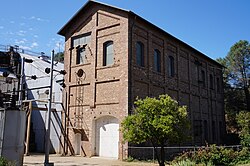Folsom Powerhouse | |
California Historical Landmark No. 633 | |
 Folsom Powerhouse on the American River in July 2015 | |
| Location | Folsom, California |
|---|---|
| Coordinates | 38°40′50″N 121°10′32″W / 38.68056°N 121.17556°W |
| Built | 1895 |
| Architect | H.T. Knight; Sacramento Electric Power & Light Co |
| NRHP reference No. | 73000426 |
| CHISL No. | 633 |
| Significant dates | |
| Added to NRHP | October 2, 1973[1] |
| Designated NHL | May 29, 1981[2] |
Folsom Powerhouse State Historic Park is a historical site preserving an 1895 alternating current (AC) hydroelectric power station—one of the first in the United States.
Before the Folsom powerhouse was built nearly all electric power houses were using direct current (DC) generators powered by steam engines located within a very few miles of where the power was needed. The use of rushing water to generate hydroelectric power and then transmitting it long distances to where it could be used was not initially economically feasible as long as the electricity generated was low-voltage direct current. Once it was invented, AC power made it feasible to convert the electrical power to high voltage by using the newly invented transformers and to then economically transmit the power long distances to where it was needed. Lower voltage electrical power, which is much easier and safer to use, could be easily gotten by using transformers to convert the high voltage power to lower voltages near where it was being used. DC power cannot use a transformer to change its voltage. The Folsom Powerhouse, using part of the American River's rushing water to power its turbines connected to newly invented AC generators, generated three phase 60 cycle AC electricity (the same that's used today in the United States) that was boosted by newly invented transformers from 800 volts as generated to 11,000 volts and transmitted to Sacramento over a 22 mi (35 km)-long distribution line, one of the longest electrical distribution lines in the United States at the time.
- ^ "National Register Information System". National Register of Historic Places. National Park Service. April 15, 2008.
- ^ "Folsom Powerhouse". National Historic Landmark summary listing. National Park Service. Archived from the original on November 14, 2007. Retrieved June 18, 2008.

